
Technology
Machinery
PRODUCT NEWS: June 2008
Maintains repeatable accuracy
October 31, 2008 By Glass Canada magazine
Add TigerStop, the
automated stop/gauge and pusher system, to new or existing equipment to
simplify processes and minimize wasted time and materials. With
TigerStop, operators can push material automatically or use it in place
of a manual stop.
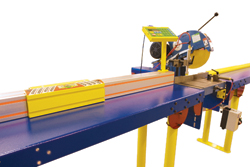 Maintains repeatable accuracy
Maintains repeatable accuracy
Add TigerStop, the automated stop/gauge and pusher system, to new or existing equipment to simplify processes and minimize wasted time and materials. With TigerStop, operators can push material automatically or use it in place of a manual stop. Material is positioned and ready to cut at the touch of a button.
An operator enters a desired dimension and the TigerStop moves to that position. The operator can confidently make the cut without measuring again and again or setting and re-setting a manual stop. This reduces operator error that results in wasted material and rework. TigerStop maintains repeatable accuracy of +⁄–0.004in to ensure parts are accurate the first time through.
Jobs are also completed in less time with greater accuracy. Operators cut more parts in a shorter period of time because they do not have to manually measure or set stops before cutting each part, allowing them to focus on getting the job done. It is easy-to-use so that any employee can produce precise parts. Stop or push material with TigerStop accuracy while reducing waste. TigerStop is a low cost addition with a great return on investment. TigerStop LLC: (360) 254-0661, www.tigerstop.com
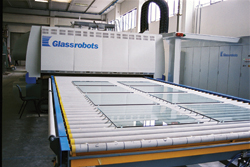 Faster heating rate
Faster heating rate
Glassrobots Oy has launched RoboTemp, a new flat tempering product family based on more than 25 years of manufacturing experience. The company says the new types of glass and coatings being introduced to the market and the continuing efforts of glass processors to achieve higher quality and greater productivity, coupled with extremely low energy consumption, are all opening the way for the modern convection technology.
Thermal or infrared radiation (IR) is becoming an outdated method for
heating glass because various coatings, especially the low-emissivity (low-E) glass, exclude the possibility of using tempering furnaces that utilize IR. As the coating on the glass heats up, it reflects the IR. Consequently, heating takes considerably longer; so capacity falls and optical quality suffers. With the convection heating system, the glass is only heated with a stream of hot air without direct radiation, so it does not matter what coating is on the glass.
In this new convection system, the airflow has a large volume and low speed and is inverter controlled. The airflow is uniform over the surface of the glass and the temperature can be profiled precisely according to the type of glass and its size.
The glass has to be kept flat from the moment it arrives in the furnace. If the glass is deformed from the heat conducted by the rollers as the glass starts to heat up in the furnace, straightening it during the final heating could be difficult or even impossible. The end result, in addition to other quality defects, is a loss of optical quality. The controls have to react extremely quickly and precisely. This is made possible by Glassrobots’ FuzzyTemp control system. As its name implies, the system applies fuzzy logic, or a different, faster and more accurate way of calculating and processing
signals compared to conventional control systems. This results in flexibility and allows mixed production.
Another factor that has an impact on process efficiency and on the quality of the end product is quenching, which also has to be carried out while controlling different parameters precisely and continuously. Quenching has to be uniform and yet rapid.
A heating time of 33 seconds per millimetre of glass thickness has been recorded as the world record for low-E glass (emissivity or = 0.02 to 0.04). However, Glassrobots’ RoboTemp has achieved heating rates of less than 30 seconds per millimetre. With clear, uncoated glass it has achieved a heating rate of 25 seconds per millimetre.
The extra capacity from the faster heating rate is not the only significant factor from the practical viewpoint. Extremely high optical quality and consistency in the end product give the glass processor a major competitive edge. For example, 4.0mm or 5⁄32in glass that has been tempered with the latest technology can be laminated: two lites of 4.0mm + 4.00mm with a thin 0.38mm or 0.015in PVB film. Until now, a 0.76mm or 0.030in film was necessary. This has a big impact on the costs of the end product. The structure of the furnace and the way it has been built, linked with effective recycling of the air within the furnace, enable the lowest level of energy consumption. The overall temperature of the furnace is kept low, about 680 degrees C or 1256 degrees F, and does not need to be adjusted for different types of glass.
Glassrobots Oy says it delivered the largest full convection flat tempering furnace in the world at the end of 2006 to a medium sized, family owned company in Germany for the
manufacture of façade glass. The furnace can handle a maximum glass size of 3.2m by 8.0m. Glassrobots has also sold the RoboTemp flat tempering lines to Oldcastle Glass and Guardian Industries in the US. Glassrobots Oy: 358-3-3132-3314, www.glassrobots.fi
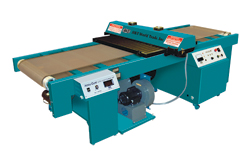 High speed curing for glass printing
High speed curing for glass printing
A.W.T. World Trade’s broad range of Accu-Cure ultraviolet curing units
provide the ideal solution for curing decorated or imprinted flat glass of all sizes. Standard Accu-Cure units can accommodate glass panels of varied thicknesses and up to 102in (259cm) wide, with larger capacities available through custom orders.
Accu-Cure’s computer designed cooling system safely cures all types of UV inks and coatings while minimizing the heat transmitted to the substrate. The company says the Accu-Cure line is another highly advanced component in its complete modular system for glass makers creating decorative or other printed glass products. For example, by adding an Accu-Print High-Tech V line of screen printers, cooling units and additional conveyor modules, glass producers can easily configure a complete large format glass decorating operation. The company says it can custom design any of the modules to meet a user’s specialized needs.
Drawing on more than 30 years of experience in UV curing technology, A.W.T. combines performance with safety in the Accu-Cure UV curing unit. An operator can adjust gate height on the curing head module to accommodate varied stock thicknesses and to eliminate light leakage. The operator also may adjust the UV lamp output from 100W to 300W or 400W, depending on the Accu-Cure model, to meet production requirements, conserve energy and prolong lamp life. In addition, the Accu-Cure ultraviolet curing unit has an ozone removal system to safely vent ozone and hot air out of the working area.
In addition to the complete conveyorized UV curing system with exhaust, the Accu-Cure is also available as a retrofit package consisting of a curing head and light guard assembly. Also available are additional conveyor sections, sold in 1.0ft (30cm) increments, as well as stand-alone conveyor units. Accu-Cure models include the standard configuration, the Accu-Cure Compact UV and the Accu-Cure 3-D. The
Accu-Cure is available in configurations of one or more lamps.
A.W.T. World Trade: (773) 777-7100, www.awt-gpi.com
 Batch laminating in-house
Batch laminating in-house
The Glass Machinery Group of Casso-Solar in Pomona, New York, has introduced a glass laminating kiln for batch operations to serve the expanding markets of companies desiring to bring low production laminating in-house at a economically viable level.
The batch laminating kiln operates by the vacuum process, which is suitable for most types of products including tempered and bent glasses with PVB, EVA or other interlayer films. Produced in standard widths of 72in, 84in and 96in and three lengths of 72in, 144in and 216in with single or double units to provide up to two independent
chambers with two bed loads in each.
The system comes complete with caster and lay-up tables, film cutter (EVA or PVB films), scissorlift, part carriers with silicone blankets, transfer deck, laminating kiln, vacuum pumps, PLC controls with touch panel and NEMA 12 control enclosure built to comply with all North American codes.
Typical process time for 3.0mm glass with 0.030in PVB and 3.0mm glass is three to three and a half hours per load. Other advantages the Casso-Solar batch laminating system offers are minimum floor space, lowest power and highest yield, comprehensive training and minimal maintenance. Additionally, Casso-Solar provides complete
systems and processing responsibility, including technical sales, training, consulting, service, spare parts and engineering support. The company utilizes nearly five decades of experience in total process support for continuous productivity.
Casso-Solar: (845) 354-2500, www.cassosolar.com
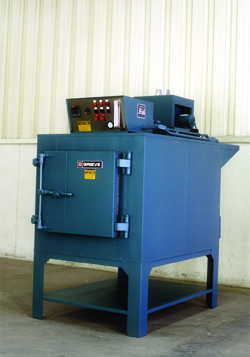 Inert atmosphere oven
Inert atmosphere oven
No. 968 is an electrically heated, 750 degrees F inert atmosphere oven from Grieve, currently used for processing glass and stainless steel components for laboratory and production use at a customer’s facility. Workspace dimensions of this oven measure 24in wide by 36in deep and 24in high.
The 12kW installed in Incoloy sheathed tubular heating elements power the unit, while a 400CFM, 1⁄3hp recirculating blower provides horizontal front-to-rear airflow to the workload. This Grieve oven features 6.0in thick insulated walls, an aluminized steel exterior, Type 304, 2B finish stainless steel interior, a door equipped with adjustable positive latching door hardware and adjustable offset hinges, plus an integral leg stand.
Inert atmosphere construction on No. 968 also includes a pressure regulator, flow meter, pressure gauge, inner oven walls sealing directly against a 1⁄2in thick silicone rubber door seal, air jacket on the inner oven for cooling, blower shaft seal, outlet with pressure relief, interior seams welded gas-tight and all wall penetrations equipped with
compression fittings.
A 325CFM blower is on-board to pull air through the air jacket on the inner oven for cooling. Controls on this inert atmosphere oven include a solenoid to open an outlet for automatic purge, digital programming temperature controller, manual reset excess
temperature controller with separate contactors and recirculating blower airflow safety switch.
The Grieve Corporation: (847) 546-8225, www.grievecorp.com
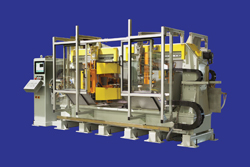 Fast notch cutting
Fast notch cutting
Glassline Corporation has introduced a new combination Waterjet/Drill technology specifically designed to meet the needs of shower door fabricators. By combining waterjet technology and drilling into one CNC system, production efficiency is greatly improved.
Waterjet technology is utilized for fast notch cutting, and eliminating the dependence on diamond tooling quality and the issues resulting from tool wear. This system provides the flexibility to cut notches at different feed rates, at desired edge quality. An optional grinding spindle can be fitted to the machine, if required, to meet any special finished notch edge requirements.
This new system from Glassline has the ability to drill as many holes as desired, anywhere around the perimeter of the part without additional setups, eliminating the need to move parts between machinery. The drilling system has top and bottom spindles to ensure the highest quality hole production. Up to two different diameter holes can be drilled within one part.
The waterjet system includes a special catch tube that eliminates the maintenance of a large tank. Precision CNC components ensure tight tolerances and repeatability. The system is managed through Windows XP CNC system and Touchscreen interface
technology. The system is network ready and contains file storage set up to hold pre-programmed notch patterns.
A CNC Waterjet/Drill System can be custom designed and built to meet customer specific requirements. Standard specifications provide for processing glass sizes from 610mm x 1220mm to 915mm x 1830mm (24in x 48in to 36in x 72in) – 2130mm
diagonal (84in).
Glassline Corporation: (419) 666-5942, www.glassline.com
Creates an optical refinement
Fleischle, a machine manufacturer based in Germany, explains the
evolution of its new machine type
called LS.
Refined flat glass is used worldwide by architects and designers as a high quality building material with many configuration possibilities. One of the processes used to apply one or multi-coloured decorations to the glass is screen printing which creates an optical refinement that cannot be achieved by other processes and materials.
The demand for colour-coated safety glass for aesthetics as well as for light transmittance and solar control is also important.
Worldwide, companies in the glass processing field have observed this trend, prompting new innovations from the manufacturer of screen printing machines.
The desire for quick changeover of the machine due to often changing production orders with differential portions, from single pieces up to series production, was the criterion which led to the new machine type by Fleischle called LS. Through a modular concept, this machine is available for delivery as semi-automatic, three-fourth automatic or a fully-automatic type. For single pieces the fully-automatic as well as the three-fourth automatic versions can be used in semi-automatic functions.
A substantial advantage of this machine type is its high flexibility. For instance, the print unit can be lifted vertically up to 500mm and moved horizontally backwards up to 1000mm via motor. For this reason, the print table and the print stencil are easily available for the machine operator. Both proceeding paths are independently regulated from each other and can be individually adjusted to the corresponding printing format.
For an optimum quality of the print image, the stable print table guarantees an evenly levelled printing plate. Through the help of blowing air, the glass pane gets positioned manually or automatically, depending on the version of the machine, to the rigid masks. The blowing air prevents scratching of the glass pane.
The standard machine is equipped with a motorized screen-lift, programmable in height independently to the squeegee path. The squeegee unit is fitted with an anti-drip system. Optimal safety is guaranteed by personal light barriers sitting at the
dangerous zones.
The essential point of the new construction is based on optimal flow of material, productivity, safety and easy operation. Depending on the demand, the LS type is available as a single machine or for integration in a complete print line with transfer conveyors and a continuous dryer.
As an option for further short-cut of the changeover time, a new developed Fleischle camera system can be used in this machine type as well as on other Fleischle machines. The exact aligning of the printing stencil towards the glass is done via two cameras within a short period of time. On the monitor, the exact alignment gets controlled optically. As a reference point, parts of the print image or the edges of the glass pane are used which will be set-up according to the print stencil. This process enables the set-up of large formats which is fast and precise to achieve an exact print for reproduction. The company has 30 years of experience in the development and construction of machines. The company sells through Casso-Solar Corporation in Pomona, New York.
Casso-Solar Corporation: (845) 354-2500, www.cassosolar.com
Contact: Fleischle www.fleischle.com
Less labour and higher throughput
GED Integrated Solutions has introduced SmartWeld i-3, a new automated vinyl welder that delivers increased flexibility, speed and accuracy. Results include less labour and higher throughput, with decreased lead times.
The advanced automation of the SmartWeld i-3 allows one operator to do the work of two. Using the SmartLoad i-3 module, the operator simply uploads the schedule and
pre-loads vinyl profiles. The profiles then run through the SmartWeld i-3 continuously. This non-stop operation and quick changeover boost throughput by up to 70 percent.
SmartWeld i-3 is part of GED’s SmartPlant vision that integrates glass and vinyl production with LeanNET software solutions to help manufacturers gain control and
eliminate confusion on the production floor. The modular availability of each i-3 vinyl and glass product allows manufacturers to gain major productivity benefits now while creating the ideal plant one system at a time.
As a part of GED’s complete line of glass and window fabrication equipment and software, the SmartWeld i-3 is backed by the company’s training and support services. It follows the company’s release of its new SmartClean i-3 vinyl corner cleaner introduced last year.
The SmartClean i-3 corner cleaner is an integral part of the company’s new generation of SmartVinyl i-3 equipment and software specifically designed to save labour and manage materials to improve cost efficiencies in window and door manufacturing. The new two-headed corner cleaner features an advanced, easy-to-use SmartLaser profile recognition system. The laser measures and automatically adjusts tool paths for high quality corner cleaning. The SmartLaser, along with advanced electronics and a highly developed drive system, combine to improve cycle times by 33 percent, resulting in higher throughput and virtually no remakes.
By measuring the profile dimensions as they are loaded into the corner cleaner, the tool path is automatically adjusted to handle vinyl’s unique variations with pinpoint precision.
This eliminates the manual system tweaks required every day with current corner cleaners due to variations in the profiles or the welding process.
System features include an on-screen touch interface for real-time data and monitoring, as well as remote programming and CAD profile importation that saves time, labour
and eliminates confusion. A new high efficiency clean out system collects vinyl dust. If desired, the dust can be removed with a filter vacuum connected to the vacuum port. n
GED Integrated Solutions:
(330) 963-5401, www.gedusa.com
Handles different glass thickness and sizes
To keep pace with steadily rising demand for architectural and insulating glass, Bavelloni pre-processing technology has created PowerSeam, a product that is completely flexible
in handling different glass thickness and sizes.
Available as a stand-alone machine or integrated into any production line, Bavelloni PowerSeam operates with one fixed and one moveable bridge, giving it the flexibility to
work with different sized glass at random. The operator or the automatic loading system, in fact, only has to supply the glass; then PowerSeam will automatically set up, measuring the sheet dimensions and adapting to its thickness. This reduces the
need for glass handling while supporting advantageous horizontal flow throughout the manufacturing process.
Based on the concept of a double edger, PowerSeam offers extraordinary levels of productivity to take full advantage of the new generation of continuous or oscillating Tamglass tempering furnaces. PowerSeam has been designed for integration with
conveyors, washing machines and other equipment as well to work independently or side-by-side with other continuous flow and/or batch production systems.
PowerSeam’s completely open electronic architecture allows its straightforward integration into customers’ existing lines and software environments. It is ideal for the
production of: insulating glass and structural glazing, solar panels, shelves, doors and interior design items to be inserted into profiles. Thanks to its reliability and sturdiness, PowerSeam can withstand highly intensive use, allowing it to operate 24 hours a day, seven days a week as modern production processes normally require.
The technical solutions chosen enable it to achieve cycle times between four and a half and eight seconds, depending on the size and sequence of the glass sheets and the number of pieces of the same dimensions. The low-E capability is available as an option. The new Bavelloni PowerSeam also offers a broad range of optional features, including a table for reading glass dimensions at the entry side.
Glaston Italy Spa: www.glaston.net
Flat and bent substrates
Glasstech featured an array of its most innovative and advanced glass processing systems during China Glass 2008, an international glass exhibition held on April 10 to 13, at the China International Exhibition Center, Beijing.
Visitors to the 19th edition of China Glass had the opportunity to see the company’s glass processing systems that produce complex automotive glass, low-E glass
and machines for the emerging solar glass market in flat and bent substrates.
Architectural systems
For glass processors involved in the architectural glass market, Glasstech manufactures systems for the efficient tempering of low-E glass, such as the architectural FCH2 Forced Convection Heater flat glass tempering system and the architectural ERH2 Electrical Radiant Heater flat glass tempering systems.
To temper glass with high efficiency coatings, Glasstech has developed convection heating concepts using either natural gas or electric heating. Its FCH2 forced convection system, fired by natural gas, is ideal for the efficient tempering of energy-saving low-E flat glass. The FCH2 can heat clear glass at a typical rate of 30 seconds per millimetre of thickness, and high performance soft-coat low-E glass at a typical rate of 33 seconds per millimetre. This reduced heating time for low-E glass provides for higher quality with less distortion and dramatically improves productivity and reduces processing cost.
The nozzles on its electric radiant heater system, the ERH2, are located above the glass line and deliver heat to the top coated surface of the glass, improving heating time for low-E coated glass to 40 to 50 seconds per millimetre of thickness, compared to a standard radiant heating system’s 70 seconds per millimetre.
Solar systems
To meet the solar energy industry’s burgeoning demand for flat and bent glass substrates, Glasstech relies on its experience in the automotive industry to develop highly specialized systems for the solar industry, which require repeatability, tight specifications, innovation and cost effectiveness.
The company’s Cylindrical Radius Bender-Solar (CRB-S) parabolic
shapes is an efficient and precise
system used in the processing of parabolic shapes for Concentrated Solar Power (CSP).
For the photovoltaic (PV) market, the Electric Radiant Heater-Solar (ERH-S) features and the Forced Convection Heater-Solar features (FCH-S) offer high productivity flat glass systems to meet the very precise flatness specifications required for active plate and cover plate processing.
The CRB-S features a forming bed that is 1700mm x 2000mm and processes glass of varying thicknesses, depending on the surface strengthening treatment required. The system will form glass from 1.6mm up to 5.0mm for the specifications and tolerances needed for solar parabolic trough reflector glass parts.
CRB-S systems maintain characteristics similar to other systems in the CRB family and are able to form constant radius shapes, J-bends and the shapes needed to comply with parabolic trough specifications. The CRB-S meets the needs of the concentrated solar power industry by delivering the tolerances and repeatability required to produce the large volume of glass parts the CSP industry will use.
Glasstech: (419) 661-9500, www.glasstech.com
Print this page
Leave a Reply